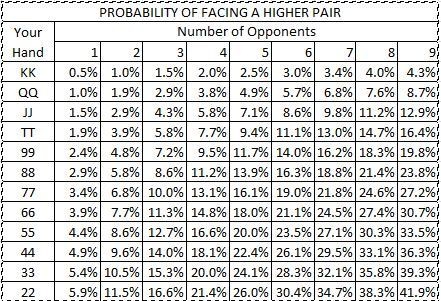Poker Hands Heads Up Probability
Posted By admin On 09/04/22To many, heads up is the purest form of poker. Playing heads up forces players to utilize many different skills in order to be successful. Some of the many skills include the ability to read hands, bluff (in correct situations), adjust constantly to your opponents playing styles, and value bet thin.
Twos, threes, tens, jacks, queens, and kings (there are 13 kinds, and four of each kind, in the standard 52 card deck). The number of such hands is (13-choose-1).(4-choose-2).(12-choose-3).(4-choose-1)^3. If all hands are equally likely, the probability of a single pair is This probability is 0.422569. Help us to 100K Subscribers - you are reading this, comment. Watch other Videos: Bluffs Gone Wrong - https://youtu.be/ffawyLHW4fY.
Cached
Another important skill that heads up players must develop is hand selection. When first starting out, some players will play nearly every hand (even out of position). They seem to think that they need to over compensate for heads up play. Other players will not play nearly enough hands causing them to lose money due to the blinds and/or their opponent's steals.
The Probabilities Of Poker hands All Math Considered
But just like anything else in poker (some will say life too), balance is important. In regards to heads up poker hand selection, you must find a middle ground between playing too many hands and not playing enough. And to help with that, I have created a basic starting hand guide below.
Poker Probability - Wikipedia
HU Poker Starting Hands - On the Button (In Position)
The button in heads up poker is no different then the button in a 6-max or full ring game - you will have position throughout the entire hand.
Because of the positional advantage, the button is where you should have the widest hand range. Many players will start by opening 100% of their hands and slowly shave their range back to adjust to how often they're being played back at by their opponent.
At the bare minimum, I will open up every suited connector, 1 and 2-gapper, broadways and pairs. I will also open any ace, king and most of my queen and jack hands with a kicker of 5 and above (all queens and jacks if suited). Any suited ten-x hand is good enough for me to open as well. If you were to look at all of these hands in Poker Stove, my range would be in the neighborhood of 70% at minimum.
Keep in mind that your range should fluctuate somewhat depending mostly on your opponent, game flow and at times even your image. If your opponent is 3-betting you relentlessly, you should open less, folding out hands you can't defend to 3-bets with. A majority of the hands you open you should be able to defend or 4-bet. On the other hand, if your opponent folds a lot pre or plays fit or fold on the flop, you can widen your hand range, sometimes playing as much as 100% of hands dealt.
When facing a 3-bet, I will have a slightly smaller range. I will generally defend versus 3-bets with any pair, any broadway, any suited ace and about half of my suited kings and queens (like K9/Q8 suited and above). I also defend with some suited connectors and one gappers like J8s or T9s. It's really villain dependent, but this should give you an idea of where I start at least.
HU Poker Starting Hands - In the Big Blind (Out of Position)

When playing heads up poker, the player in the big blind will be the player who is out of position for the entire hand. This is a huge disadvantage and because of this, you should tighten up the range of hands that you defend with.
As a rule of thumb, I will defend any pair, any suited ace, A9 off-suit and up, almost all of my broadways and suited connectors/1-gappers like J8s and maybe T9s. Looking at Poker Stove, my hand range will be close to 35% or 40% out of position. About 10% of these hands (suited connectors, suited kings, some suited queens) I will 3-bet with preflop.
Again, it's important to realize that this is more or less a default hand range. You should be adjusting the hands you're defending with according to how tight/loose your opponent is. The tighter your opponent, the tighter the hand range you should be defending with. The looser your opponent, the wider you can defend.
HU Poker Starting Hands - Summary
It should be painfully obvious that your opening hand range in a heads up game is much wider than what it would be in a 6-max or full ring game. If your preflop hand range isn't this wide (or close), you're too tight and you should widen up as it is likely costing you money.
At the same time, I hope that you noticed that none of my preflop ranges outlined above are set in stone. Starting hand ranges in any poker game shouldn't be. You should be basing your preflop hand ranges based on your opponents, game flow and image. Your exact hand range will always be fluctuating.
So while a guide like the one I posted above will definitely help you in becoming a better heads up player, knowing how to adjust for the different in-game variables will help you in becoming not only a profitable heads up player, but a profitable poker player overall.